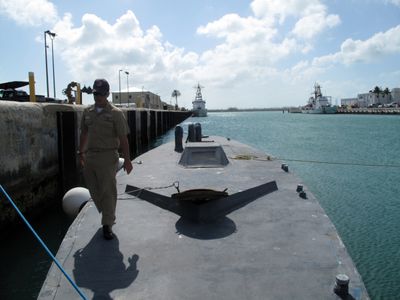Cocaine-laden subs on rise, hard to find

MEXICO CITY – When anti-narcotics agents first heard that drug cartels were building an armada of submarines to transport cocaine, they thought it was a joke.
Now U.S. law enforcement officials say more than a third of the cocaine smuggled into the United States from Colombia travels in submersibles.
An experimental oddity just two years ago, these strange semi-submarines are the cutting edge of drug trafficking today. They ferry hundreds of tons of cocaine for powerful Mexican cartels that are taking over the Pacific Ocean route for most northbound shipments, according to the Colombian navy.
Sub-builders are even trying to develop a remote-controlled model, officials say.
“That means no crew. That means just cocaine, or whatever, inside the boat,” said Michael Braun, a former chief of operations at the U.S. Drug Enforcement Administration.
The subs are powered by ordinary diesel engines and built of simple fiberglass in clandestine shipyards in the Colombian jungle. U.S. officials expect 70 or more to be launched this year with a potential cargo capacity of 380 tons of cocaine, worth billions of dollars in the United States.
“This is definitely the next generation of smuggling conveyance,” said Joseph Ruddy, an assistant U.S. attorney in Tampa, Fla., who prosecutes narco-mariners.
The submersibles are equipped with technologies that make them difficult to intercept, even though U.S. forces use state-of-the-art submarine warfare strategies against them. Authorities say most slip through their net.
“You try finding a floating log in the middle of the Pacific,” one DEA agent said.
U.S. officials and their Colombian counterparts have detected evidence of more than 115 submersible voyages since 2006. They have apprehended the crews of more than 22 submersibles at sea since 2007. Six crews have been arrested this year. The Colombian navy has intercepted or discovered 33 subs since 1993.
U.S. officials fear the rogue vessels could be used by terrorists intent on reaching the United States with deadly cargos.
The vessels do not fully submerge but skim the sea surface. They move quickly at night, then drift like sleeping whales during the day. Under cover of darkness, they slither out of Colombia’s shallow rivers and 10 days later rendezvous offshore along the Central American coast, usually near Guatemala, where cocaine is offloaded and the subs are sunk.
Smugglers first experimented with heavy steel subs dubbed “coffin ships” by the Colombians. Trial and error quickly advanced their capabilities.
“These vessels are intelligently designed. They are not very comfortable, but they are now very seaworthy. They are capable of carrying multiton cargos. They can travel thousands of miles without refuel or resupply. And they are very hard to detect,” said U.S. Coast Guard Rear Adm. Joseph Nimmich, director of the Joint Interagency Task Force South, which pursues drug interdiction in the Caribbean and eastern Pacific Ocean.
Nimmich stood on a dock at the task force’s headquarters in Key West, Fla., beside a vessel dubbed Big Foot II. Captured last year 350 miles off the Guatemalan-Mexican coast, the sub had a four-man Colombian crew and 6.4 tons of cocaine aboard, worth more than $100 million.
Almost 60 feet long, the craft employed water-cooled exhaust mufflers to reduce its infrared heat signal. It was camouflaged in blue-gray paint. A small conning tower jutted from the deck at an angle designed to confuse radar signals.
The latest submersibles can go 3,000 miles without refueling.
Officials estimate that the subs cost about $1 million to manufacture in Colombia. Colombian officials say former military personnel might be helping to design, construct and direct the vessels.
Colombian navy Adm. Guillermo Barrera said the subs usually carry 4 to 10 tons of cocaine. They typically have a crew of four – including a captain, an engineer and a seaman. The fourth crew member is usually a representative of the owner. With cargos worth $100 million or more, “you want to know where they’re headed,” Barrera said.
According to officials, crews are well compensated, splitting as much as $500,000. The work is dangerous; the subs cross stormy sea lanes without lights, with a shifting ballast of fuel and drugs. The cabins are hot and cramped, with a bucket for a latrine and a floor to sleep on.
U.S. officials say submersibles are escorted by countersurveillance vessels, disguised as fishing trawlers, that warn them of nearby navy cutters or spotter planes. Nimmich said the sub crews use radios infrequently and speak in code. Until recently, submariners caught by authorities could not be charged in the United States or Colombia if the cocaine was scuttled.
“The vessels are built to sink. When they open the valves, tons of water come in, and in a minute, or a minute and a half, they sink,” Barrera said. “There is no evidence, and what starts as a counterdrug operation becomes a rescue operation.”
U.S. and Colombian agents have been frustrated in this cat-and-mouse game. “With no drugs found, we couldn’t prosecute,” said Ruddy, the assistant U.S. attorney. At least eight crews have been returned to Colombia after rescue, without being charged.